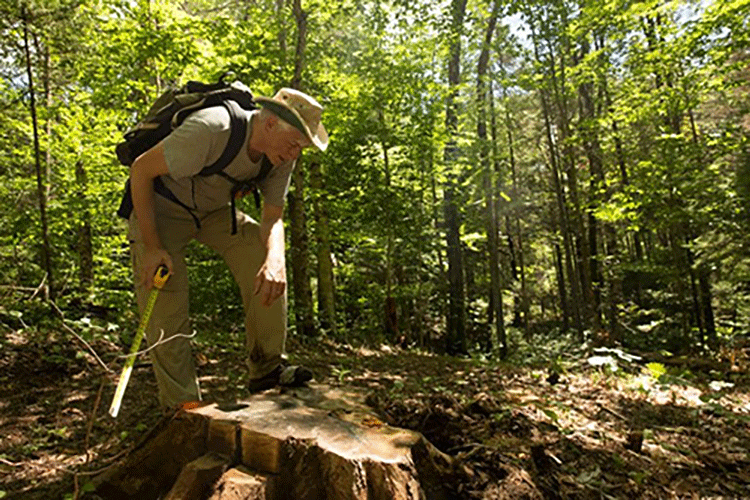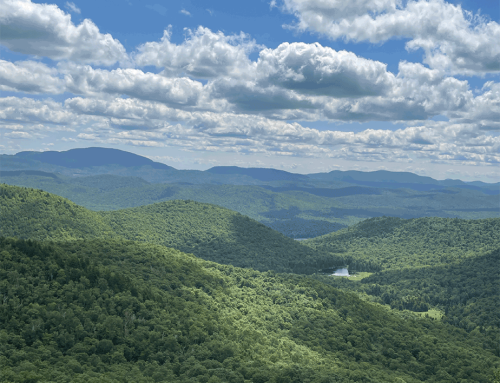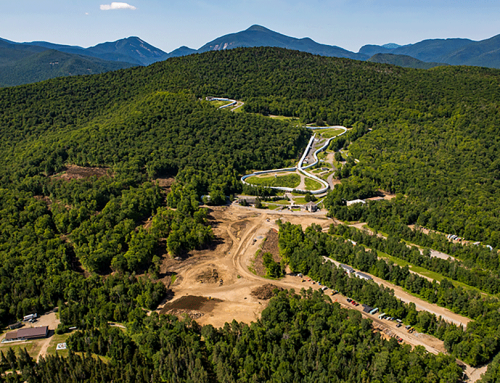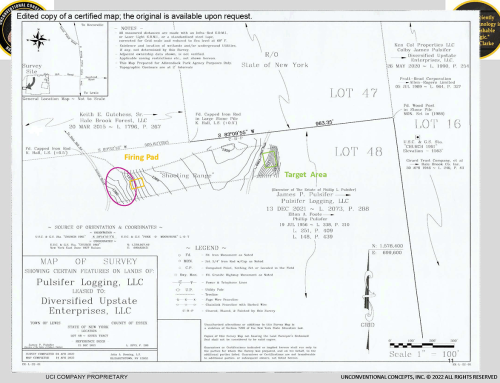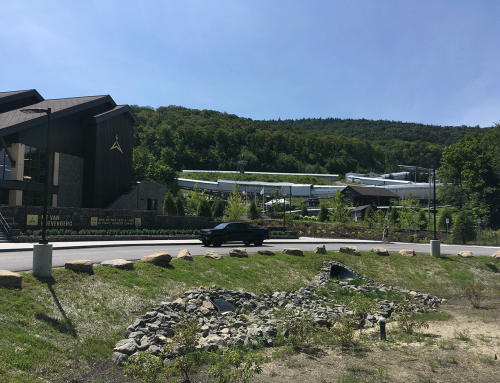In the July 2019 legal decision in favor of Protect the Adirondacks, regarding the constitutionality of excessive tree cutting by state agencies to build a network of Class II community connector snowmobile trails in the Adirondack Forest Preserve, the Appellate Division, Third Department, ruled that the cutting of over 25,000 trees to build these trails violated Article 14, Section 1, of the state Constitution, the famed “forever wild” provision.
This article looks at the meaning of Article 14, Section 1, in light of this new ruling. (A related article dealt with use of the word “timber” in Article 14 of the state Constitution). This article looks at how small diameter trees have long been protected in Forest Preserve legal practice. Article 14 reads: “The lands of the state, now owned or hereafter acquired, constituting the forest preserve as now fixed by law, shall be forever kept as wild forest lands. They shall not be leased, sold or exchanged, or be taken by any corporation, public or private, nor shall the timber thereon be sold, removed or destroyed.”
The previous article discussed how the historic record shows that common usage of the word “timber”, as used by the framers of Article 14, meant wooded lands or a stand of trees. The word “timber” included all trees in the forest, both big and small. The July 2019 Appellate Division, Third Department, ruling is important because it confirms that earlier court decisions involving Article 14, Section 1, from the 1930s and 1990s, specifically protected all trees on the Forest Preserve, both big and small, and rejected the State’s claim that cutting over 25,000 trees would be immaterial and insubstantial.
At the 2017 trial in this case, Protect the Adirondacks provided expert testimony by a forest ecologist on the number of trees cut, or marked for cutting, to build the State’s first network of Class II trails. This testimony involved both tree counts on each trail section, and testimony about the ecological importance of small diameter trees in the forest. The Appellate Division found this testimony convincing.
The court stated:
Although tree size and maturity may be considered in determining whether a proposed project’s tree cutting is substantial or material, plaintiff presented expert testimony debunking the assumption that smaller trees are necessarily young or immature; some forest trees measuring less than three inches DBH can be more than 100 years old, and smaller mature trees play an important role in the continuing ecology of the forest. The court generally accepted the tree counts proffered by plaintiff, including for trees less than three inches DBH. Accepting those factual findings, approximately 25,000 trees either had been or would be cut to construct the trails.
When organizing its case for trial, Protect the Adirondacks independently conducted its own count of Forest Preserve trees that had been cut down, or marked to be cut down, to build Class II trails. The trial focused primarily on four new trails, in addition to a number of smaller trails, where the state had built, or was in the process of building, wide road-like Class II snowmobile trails: 1) the 11.7-mile Seventh Lake Mountain Trail in the Moose River Plains Wild Forest; 2) the 13-mile Newcomb to Minerva Trail in the Vanderwhacker Mountain Wild Forest; 3) the 3-mile Gilmantown Trail in the Jessup River Wild Forest; and 4) the 3.3-mile Cooper-Kiln Trail in the Wilmington Wild Forest. All told, there were 11 trails involved, with a total length of 34 miles. On these trails, the DEC had detailed in its work plans and Environmental Notice Bulletins the planned cutting of some 6,000 trees over 3 inches DBH (diameter at breast height).
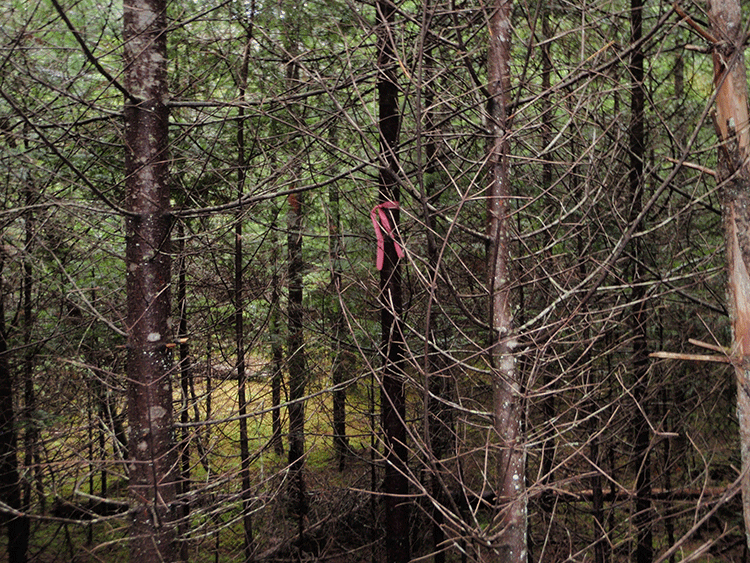
The flag marks the center part of an uncut section of the Class II snowmobile trail from Newcomb to Minerva. This section of trail would be 9-12 feet wide. Note the many trees that would need to be cut down of all sizes.
Protect the Adirondacks went into the field for weeks in 2015 and 2016 to count either stumps on the ground or standing trees that were marked to be cut on these Class II trails. Where we found a tree stump of 1″ DBH or greater on the four primary trails we photographed that stump with a tape measure across it at the point of its smallest diameter. Shrub species were not counted, only trees. For each stump we recorded the GPS location and size. All told, Protect the Adirondacks photographed over 9,500 stumps on the Seventh Lake Mountain Trail, the Gilmantown Trail, the Cooper-Kiln Trail, and a 1.5-mile section of the Newcomb to Minerva Trail that runs from the Camp Santanoni parking lot to Harris Lake. We counted over 8,000 stumps on other sections of the Newcomb to Minerva Trail. We also inventoried over 5,700 standing trees that were flagged or marked for cutting on 3.5 miles of the Newcomb to Minerva Trail on both sides of the Boreas River. Protect the Adirondacks documented widespread cutting of trees between 1″-3″ DBH. All of this documentation was provided as part of the expert testimony in the 2017 trial.
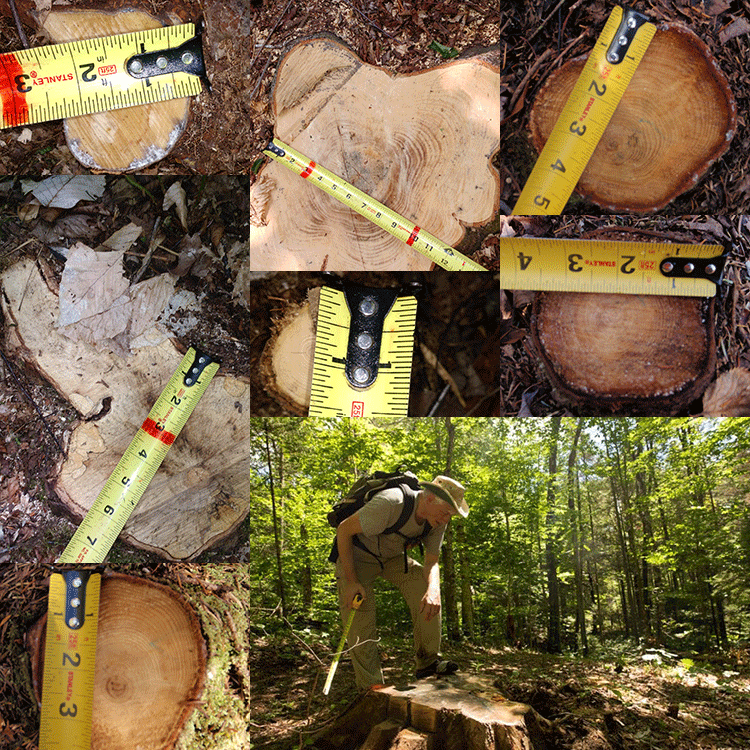
This picture shows pictures of stumps on various Class II trails. PROTECT counted over 25,000 tree stumps and standing trees and submitted over 9,000 pictures of measured stumps during the 2017 trial.
It’s important to note that these figures for tree cutting on Class II trails are conservative. On the sections of trail where the trail was uncut, but marked with flags or painted trees, we counted only trees within a 9-foot corridor. Class II trails are built to a standard width of 9-12 feet and often exceed 12 feet in width for “bench cuts”, which are widely used. Trail sections with bench cuts see clearing on both the upslopes and downslopes of trailsides and these areas are subject to grading and tree cutting beyond the 12-foot trail width. Additionally, the 11.7-mile Seventh Lake Mountain Trail and the 1.5-mile trail from Santanoni to Harris Lake trail were both heavily graded with an excavator to level and flatten the trail surface, which destroyed many tree stumps before we could count them. For instance, on the Seventh Lake Mountain Trail the DEC reported that it cut 2,085 trees that were 3″ DBH or greater. Due to the widespread grading of the trail by the DEC during construction, Protect the Adirondacks could only find 893 stumps that were 3″ DBH or greater, roughly 43% of the total. We also photographed 5,116 stumps that were 1-3″ DBH there. If 57% of the small diameter tree stumps were also lost to grading, consistent with the rate for large diameter trees, the destruction of small trees could have reached almost 12,000. We’ll never know the total extent of tree destruction on the Seventh Lake Mountain Trail. Our trail count of 893 big trees and 5,116 small trees is far from the complete picture.
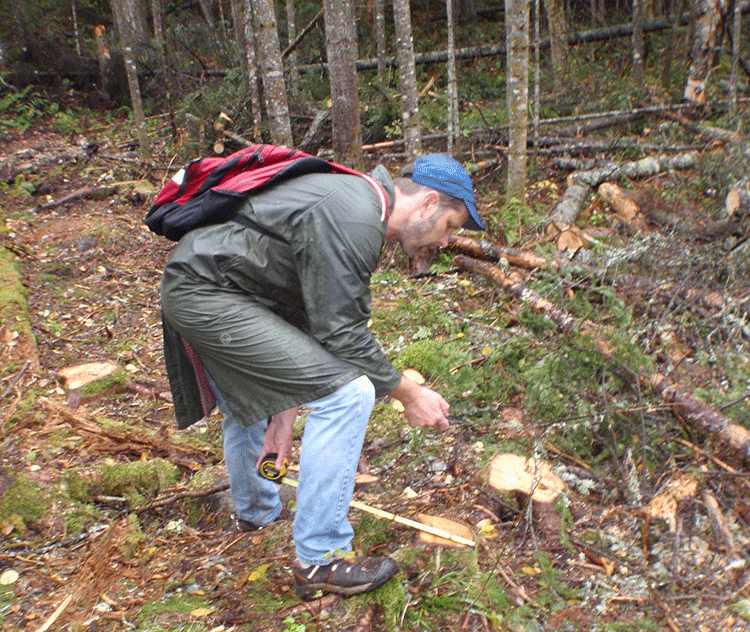
Forest ecologist Steve Signell documenting tree cutting on a Class II trail in preparation for the 2017 trial.
In addition to the tree count testimony outlined above, which provided information on the true extent of tree (timber) destruction on the Forest Preserve to build Class II trails, the forest ecologist provided testimony on the role and importance of small diameter trees in the forest. Small diameter trees often persist for decades in the mature forests that dominate the Forest Preserve, growing minutely in diameter while simultaneously growing significantly in height, as they bide their time waiting for an opening in the forest canopy. There are many “shade tolerant” trees that grow in the forest understory. Though less than 3″ DBH, these trees often have tight growth rings that show they have lived for decades. The forest ecologist provided data on small diameter stumps where he counted tree growth rings and found trees that were 50 years old, 60 years old, and more than 80 years old. Small diameter trees are not ephemeral seedlings, as they are often mischaracterized by state foresters, but are often shade-tolerant tree species that have out-competed dozens of other trees over the decades as they awaited their opportunities to take advantage of a canopy opening.
The forest ecologist also testified that it was common for small diameter trees to reach significant heights of 25 to 50 feet or higher, depending on the tree species. The DEC’s expert scientific witness also testified that small diameter trees of less than 3″ DBH commonly reached heights of 30, 40 or 50 feet.
DEC has utilized a tree cutting policy for decades that only considered a tree to be a tree if it was 3″ DBH or greater. DEC’s own staff and expert witnesses testified that this standard was not based on science or forest ecology and could not provide any basis for it. Should the State be using a policy that relies on an arbitrary DBH standard, or should it have a tree cutting policy based on forest habitat and forest ecology science?
While some Adirondack leaders have disparaged the small diameter trees counted by Protect the Adirondacks “as tiny wooden stems, seedlings, saplings, brush,” the evidence that Protect the Adirondacks presented at the trial was voluminous, well documented, and compelling. A 75-year-old tree is a tree by any standard, even if it is less than 3″ DBH. The diameter of a tree does not determine its ecological significance to the forest, and its diameter does not determine whether or not it is protected by Article 14.
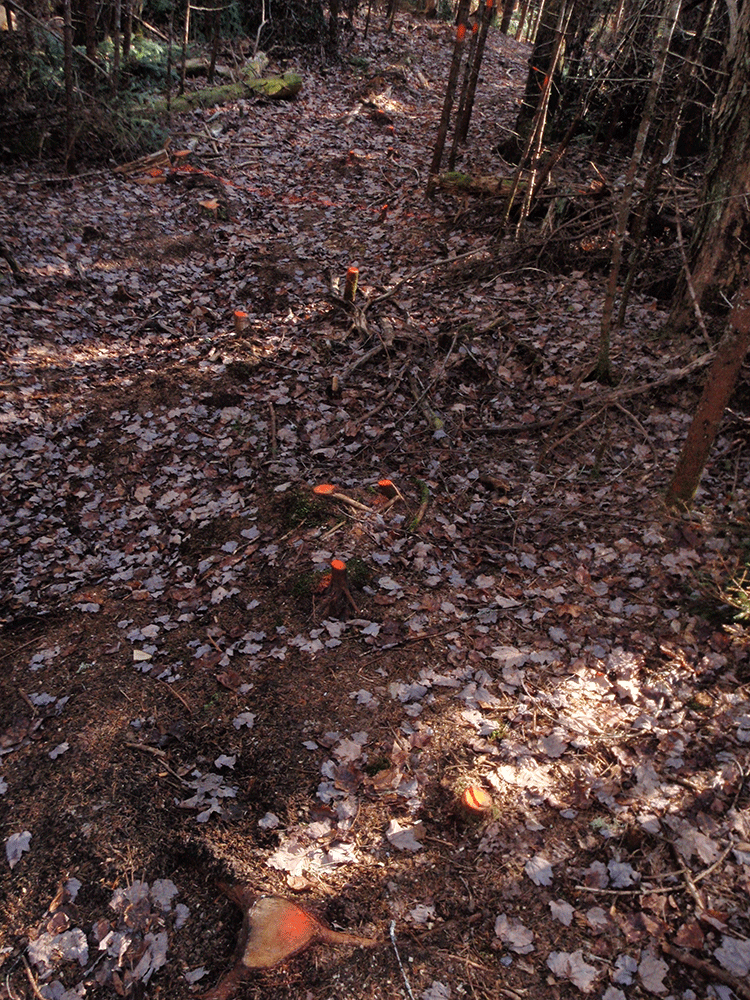
A section of Class II trails that was partially cut out but not graded with heavy equipment. The orange paint marks stumps that need too be cut to ground height and trees that need to be cut to widen the trail.
After the trial in 2017, the Supreme Court judge ruled against Protect the Adirondacks, but in doing so he acknowledged that the word “timber” in Article 14 included all trees. While the trial judge ultimately ruled for the State, he flatly rejected its argument that the Constitution protects only trees of 3″ DBH or greater, which DEC deemed to be “merchantable timber,” and the judge wrote that smaller trees are protected by the Constitution. The decision stated:
Based on such testimony, particularly with regard to pulp logging operations, as well as to the historical use of the terms “tree” and “timber” interchangeably, the Court finds that the reference to “timber” in the constitutional provision at issue herein refers to all “trees”, the definition of which includes any independent growth of a species that is biologically identified as a tree, no matter the size.
The 1930 Association for the Protection of the Adirondacks v MacDonald case, brought against Alexander MacDonald, the state Conservation Commissioner at the time, focused on the potential cutting of 2,500 trees on roughly 4.5 acres of Forest Preserve lands on the flanks of the Sentinel Range to build the bobsled track/and return road for the 1932 Winter Olympics. This is the first seminal court case that dealt with Article 14, section 1. Like the framers of Article 14, the courts in the Association case in 1930 used the words “trees” and “timber” interchangeably. Here are key excerpts from the Court of Appeals decision in the Association case, which ruled that the State’s planned tree cutting violated Article 14. Note the court’s references to “large and small” trees and “trees and timber”:
The bobsleigh run will be approximately 1 1/4 miles in length and 6 1/2 feet wide, with a return route or go-back road. As additional land will have to be cleared on either side of the run, the width in actual use will be approximately 16 feet, and 20 feet where the course curves. It is estimated that the construction will necessitate the removal of trees from about 4 1/2 acres of land, or a total number of trees, large and small, estimated at 2,500.
…
The purpose of the constitutional provision, as indicated by the debates in the Convention of 1894, was to prevent the cutting or destruction of the timber or the sale thereof, as had theretofore been permitted by legislation, to the injury and ruin of the Forest Preserve. To accomplish the end in view, it was thought necessary to close all gaps and openings in the law, and to prohibit any cutting or any removal of the trees and timber to a substantial extent. The Adirondack Park was to be preserved, not destroyed. Therefore all things necessary were permitted, such as measures to prevent forest fires, the repairs to roads and proper inspection, or the erection and maintenance of proper facilities for the use by the public which did not call for the removal of the timber to any material degree. The Forest Preserve is preserved for the public; its benefits are for the people of the state as a whole. Whatever the advantages may be of having wild forest lands preserved in their natural state, the advantages are for every one within the state and for the use of the people of the state. Unless prohibited by the constitutional provision, this use and preservation are subject to the reasonable regulations of the Legislature.
…
What may be done in these forest lands to preserve them or to open them up for the use of the public, or what reasonable cutting or removal of timber may be necessitated in order to properly preserve the State Park, we are not at this time called upon to determine. What regulations may reasonably be made by the commission for the use of the park by campers and those who seek recreation and health in the quiet and solitude of the north woods is not before us in this case.
…
In other words, this plea in behalf of sport is a plea for an open door through which abuses as well as benefits may pass. The Constitution intends to take no more chances with abuses; and therefore says the door must be kept shut. The timber on the lands of the Adirondack Park in the Forest Preserve, or that on the western slope of the Sentinel range, cannot be cut and removed to construct a toboggan slide simply and solely for the reason that section 7, article 7 of the Constitution, says that it cannot be done.
The historic court Record in the Association decision contains a chart titled “Live Timber” that listed 1,710 trees over 3″ DBH and another chart titled “dead Timber” of 10 trees to be cut to build the bobsled track. Another 50% of that amount was estimated by the courts to be cut for the narrower return road for the planned bobsled track. The Court of Appeals decision talks about 2,500 “large and small” trees. This case did not deal specifically with small diameter trees, but the massive level of cutting of larger trees was, alone, sufficient for the court to find the project to be unconstitutional, even without considering the additional smaller trees that would have been destroyed.
The Association case did provide standards to judge the constitutionality of tree cutting on the Forest Preserve. This decision ruled that tree cutting could occur on the Forest Preserve for management activities so long as it was not done to a “material degree” or to a “substantial extent.” The court told us that the cutting of 2,500 trees on the Forest Preserve in 1930 went beyond a material degree and a substantial extent. The court did not tell us exactly when that line was crossed. Was it crossed at 1,500 trees or 1,000 trees or 500 trees or 100 trees? All we know is that the proposed cutting of 2,500 trees, both “large and small,” was found to violate Article 14.
Small diameter trees figured in the second seminal court case that has helped to shape Forest Preserve management under Article 14, Section 1. Fast forward 63 years to 1993, to the Balsam Lake Anglers Club v DEC case, which included small diameter trees under 3″ DBH in the court’s legal analysis and decision. In that case a fishing club in the Catskills protested the widening of a foot trail by the DEC to accommodate cross-country skiing on the Catskill Forest Preserve. In that case, the Record showed that approximately 350 trees of 1″ DBH or more were cut, or marked to be cut, for the construction of two trail sections totaling approximately 2. 3 miles. This cutting was approximately 152 trees of that size per mile. Moreover, just 78 trees of 3″ DBH or greater were to be cut, meaning that just 34 large trees were scheduled to be cut down per mile. The Appellate Division, Third Department, relied upon these tree counts in reaching its decision at that time.
The “material degree” and “substantial extent” tests created by the Court of Appeals in the Association case were utilized by the courts in the Balsam Lake case. The cutting proposed by the DEC on the Balsam Lake Wild Forest trails was found by the courts to be immaterial and insubstantial. Yet, it’s also important to note that the DEC counted trees of all sizes, both large and small, in this case, and the courts used this information in their decisions.
For decades now, the Balsam Lake case has provided the lower threshold for permissible tree cutting on the Forest Preserve, while the Association case provided an upper limit. A clear line of where in that range tree cutting reaches a “material degree” or a “substantial extent” has not emerged with any specificity. What is clear is that tree cutting on the Forest Preserve for recreational trail construction is permitted, but only a very limited amount.
As noted in the Association and Balsam Lake decisions, the destruction of a limited number of trees on the Forest Preserve is permitted, for a permissible purpose, but only if it is not a material or substantial amount. In July 2019, the Appellate Division, Third Department, clearly placed its decision within the historic legal framework of Article 14 case law precedents. The court concluded that the cutting of over 25,000 trees on the Forest Preserve was clearly outside the legal guardrails that had been long established, blowing well beyond the tree cutting levels that were found to violate Article 14 in the Association case:
Although this project did not involve clear-cutting or the removal of a large swath of trees (compare Association for Protection of Adirondacks v MacDonald, 253 NY at 236), but instead necessitated destruction of narrow corridors of trees for many miles, we need to consider the entire project when determining its effects. The destruction of a substantial number of trees can be problematic whether those trees were together or spread out along one or more portions of the Forest Preserve. For example, the construction of these trails required the destruction, on average per mile, of over 200 trees at least three inches DBH and approximately 925 trees of all sizes. It would be anomalous to conclude that destroying 925 trees per mile of trails, or approximately 25,000 trees in total, does not constitute the destruction of timber “to a substantial extent” or “to any material degree” (id. at 238; see 1954 Ops Atty Gen 157 [concluding that the constitutional provision prohibits relocating a portion of existing highway in the Forest Preserve that would involve the cutting of approximately 5,000 trees]). Thus, the construction of the Class II trails resulted in, or would result in, an unconstitutional destruction of timber in the Forest Preserve.
The summary of the court’s decision in July 2019 is that Article 14 does not provide protection to some trees, but not to others. It provides protection to all trees. State agencies have been allowed to, and will continue to be able to, undertake any number of management activities on the Forest Preserve in order to maintain and protect it and to provide for public recreational activities, provided that the destruction of trees/timber does not occur “to a substantial extent” or “to a material degree.” The court found that the cutting of 25,000 trees to build a network of Class II trails violated these standards, and so under longstanding legal precedents, it was unconstitutional.
After the Appellate Division decision in July 2019, Seven Days news magazine of Burlington, Vermont, reported on the legal victory of Protect the Adirondacks. The ending quote from Pace University law professor Nick Robinson was spot on: “Though some were taken aback by the ruling, they shouldn’t have been, said Robinson, the Pace University professor. ‘I think it’s surprising to the people who don’t read the cases,’ he said. New York’s constitution is quite clear, he added. ‘The forest preserve is to be kept as forever wild forestland’.”

